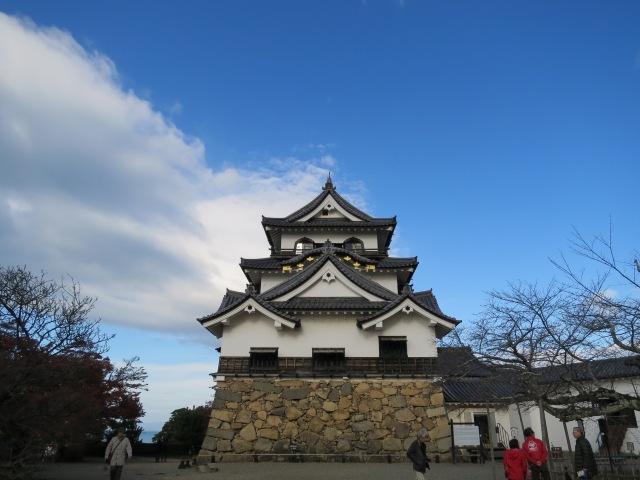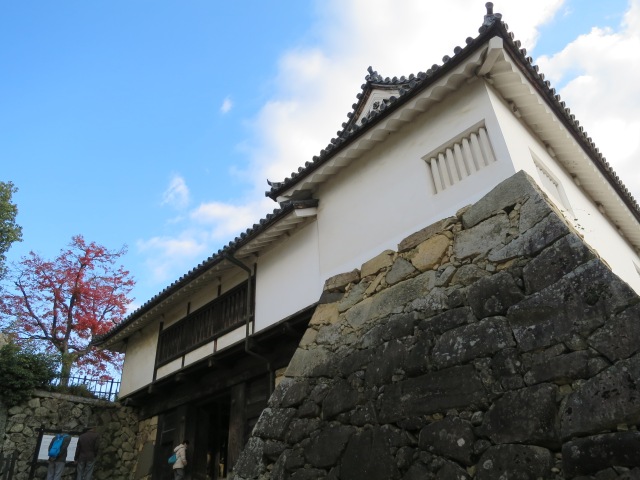Date: 25th November 2017
Hikone Castle / Hikonejō (彦根城) is a hilltop castle in Hikone, Shiga Prefecture, one of Japan’s 12 original castles.

The construction of the castle was instructed by Ii Naokatsu, son of daimyo Ii Naomasa in 1603. Naomasa is one of the Tokugawa-shitenno / Four Heavenly Kings of the Tokugawa, who resided in nearby Sawayama castle after the Battle of Sekigahara. Due to the ineffective defense system of the castle, Naomasa decided to destroy the castle and build Hikone castle instead. However, death came upon him before Hikone castle could be built.

Tokugawa Ieyasu decided that the new castle was to be built on Mount Hikone, and due to the strategic location of the castle (overlooking Nakasendo, one of the the routes connecting Kyoto and Edo), the construction was quickened by using materials from other temples and castles. Such example is the tenshukaku (castle keep) which was originally part of Otsu Castle. Parts of Nagahama Castle, which was demolished in 1615 were used for Hikone Castle as well.

The castle was only completed in 1622 when Ii Naotaka, Naokatsu’s brother gained authority over Omi Province and thus stones from Sawayama Castle could be used for Hikone Castle.

Many castles perished during the Meiji era as the new government wanted to remove the powerful symbol of Tokugawa which was reflected in the feudal castles. However, Emperor Meiji who was visiting Hikone requested that the castle was sparred from demolition, influenced by his advisor at that time.

Despite the small 3-story tenshu, the castle’s moats are some of the best I have seen (not that I have seen many, but yes).

Approach to the main keep is through a spiral ramp, arriving at a wooden bridge, Roka-bashi which can be destroyed if enemies are seen (from the turrets) approaching the castle.


Nobori Ishigaki, uphill stone walls built along the mountain slopes, which is rarely found in Japanese castles can be found here as well.

Jiho-sho, a huge bell can also be seen here, which was used to announce the time to the castle town people in the feudal age. Today, the bell is still tolled every 3 hours from 6 a.m. to 6 p.m. and is even designated as one of the 100 Soundscapes of Japan.

The castle also retains its umaya (wooden stable), the only surviving feudal castle stable in Japan today.

The Yoshino sakura are planted on the grounds of the castle, creating a beautiful sight in spring. The sakura are also lighted up during nighttime, from April 1st to 20th (subject to change based on the blooming time).


The castle is supposedly beautiful in the moonlight as it appears to float in the air, making it one of the Eight Views of Lake Biwa (not to be confused with the Eight Views of Omi).

Do not forget to visit the Hikone Castle Museum as well as it will add to your experience here in the castle with its exhibition of artifacts from the Ii clan, the lord of the castle for 250 years. Part of the castle museum is the partially reconstructed former palace buildings which includes a nice little garden. This is different from Genkyu-en, the large landscape garden in the castle grounds, which deserves its own post (look forward to it next week).


I enjoyed my visit to Hikone Castle very much, having spent a total of 3 hours visiting the castle, castle museum and Genkyu-en. Do not lose interest just because the main keep is only 3 stories tall. Being a hilltop castle means that it provides some of the best scenery, and the spacious castle grounds, along with its intact buildings allow the visitors to experience a more “complete” Japanese feudal castle.

Info
Hikone Castle
- Opening hours: 8:30 – 17:00
- Admission fee: 600 yen (castle and Genkyu-en), 1000 yen (castle, Genkyu-en and museum)
Hikone Castle Museum
- Opening hours: 8:30 – 17:00
- Various closing days (visit site to check)
- Admission fee: 500 yen (museum), 1000 yen (castle, Genkyu-en and museum)
Further reading:
- Official Hikone Travel Guide
- Nakasendo Way – This page gives you a history of the Hikone Castle Town
Access
Hikone castle is a 15-20 minutes walk from Hikone Station, my recommendation is to go through the Yume Kyobashi Castle Road, giving you a feel of Hikone’s old town. Stop by one of the shops for souvenirs, snacks, lunch or tea.


To Hikone Station:
From Kyoto: 50 minutes on the local line (1,140 yen), if you take the bullet train from Kyoto to Maibara then transfer to the local line for Hikone, it could save you 15 minutes, but would cost 3,580 yen.
From Nagoya: Take the bullet train from Nagoya to Maibara, then transfer to JR Haruka / Biwako line to Hikone. The total trip will take 37 to 45 minutes depending on whether you take the Kodama / Hikari shinkansen and Haruka / Biwako lines, and will cost 3,220 to 3,450 yen. A cheaper option (1,490 yen) will take at least 1 hour and 20 minutes, via the JR Tokaido and Biwako lines, with transfers at Ogaki and Maibara stations.


Thank you for sharing beautiful pics and history. I go to Lake Biwa every year for vacation. At the last visit, we talked about Hikone castle. I love to visit there. Place of Hikonyan, right ?
LikeLiked by 1 person
Yes. Love the cute Hikonyan mascot.
LikeLike
Pingback: Genkyuen Garden, Hikone Castle – Replica of Eight Views of Omi – Japan Wonders
Pingback: Autumn at Kongourinji of the Kotosanzan temples, Shiga Prefecture – Japan's Wonders